You have /5 articles left.
Sign up for a free account or log in.

Getty Images
Pay for full-time faculty members rose 2.6 percent this academic year over last, according to “Visualizing Change,” the American Association of University Professors’ Annual Report on the Economic Status of the Profession. But professors shouldn't get too excited: adjusted for inflation, that amounts to just 0.5 percent.
Although average faculty salary increases this year are fairly close to the increases the past two years, a relatively high Consumer Price Index in many metropolitan areas “means the real buying power of any increases [is] substantially diminished,” said Samuel J. Dunietz, a senior program officer at AAUP who helped write the report.
Released today, AAUP’s annual survey finds that the average salary for full-time ranked faculty members was $80,095 in 2016-17, while the average total pay for part-time faculty members at a single institution was $20,508. Average pay for part-time faculty members teaching on a per-section basis only (excluding professors teaching part-time during phased retirement, for example) was $7,066, with serious limitations to the data.
The compensation data above are collected annually by the American Association of University Professors. Participation in the AAUP survey is optional; 1,022 institutions submitted data for the 2016-17 academic year.
Pay Data for 1,022 Institutions
Inside Higher Ed offers an
exclusive database of faculty pay
from the American Association
of University Professors. Click
here to check out your college
or university.
Full professors earned $102,402, on average, across ranks, disciplines and institution types. They also saw the largest increase in salary from 2015-16, of about $2,956, on average. Associate professors earned $79,654 and enjoyed a $2,462 average bump in pay. Assistant professors made $69,206, up by about $2,224 from the year prior.
Salaries for continuing faculty members, who have served one or more years at the same institution, increased at all ranks, by about 1 percent, adjusted for inflation, according to AAUP. For continuing full professors, the bump was about 0.6 percent, and 1.2 percent and 1.5 percent for the entire population of associate and full professors, respectively. Yet AAUP found no evidence of widespread salary inversion or compression, in which junior faculty members make the same or more than their more senior colleagues.
While the gap between junior and senior ranks “may be narrowing slightly,” reads AAUP’s report, “it would take a long time for assistant professors to catch up even to associate professors at the current rate. In addition, a very high increase in salaries at a few institutions could skew the average.”
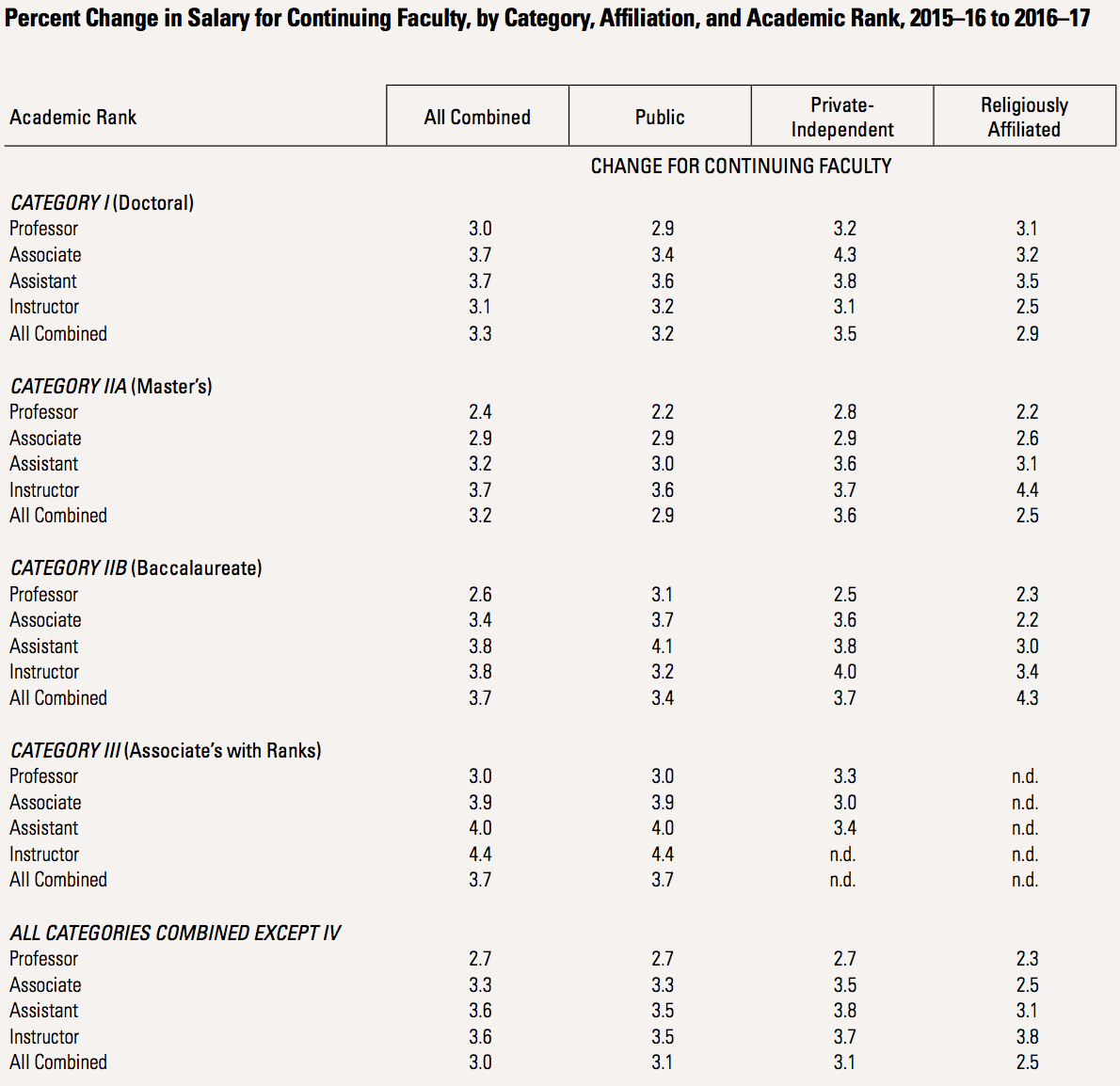
AAUP expressed concern over the declining share of full-time, tenure-track faculty members across academe, however -- about a 50 percent drop since 1975. “With fewer tenured and tenure-track positions, U.S. higher education is less likely to be an engine for pedagogical and research innovation, since non-tenure-track faculty usually have less freedom to take risks in the classroom and in the laboratory,” the report says.
Men vs. Women
Gender-based pay disparities are also evident at all faculty ranks, with male full professors earning $104,493, on average this year, compared to $98,524 for women. Among associate professors, men earned $80,895, while women earned $77,751. Male assistant professors earned $70,446 and women earned $67,647. These findings parallel those included a recent faculty salary report from College and University Professional Association for Human Resources, which put the overall pay ratio at 0.87 (meaning that women make $0.87 on the dollar compared to men).
AAUP’s data, available here exclusively from Inside Higher Ed, also includes pay-parity ratios by institution. While ratios are high at many institutions, some -- including Vanderbilt University -- have achieved virtual pay parity (99.6). Some institutions even have higher average professor salaries for women than for men: Notre Dame of Maryland University, for example, has a ratio of 111.9.
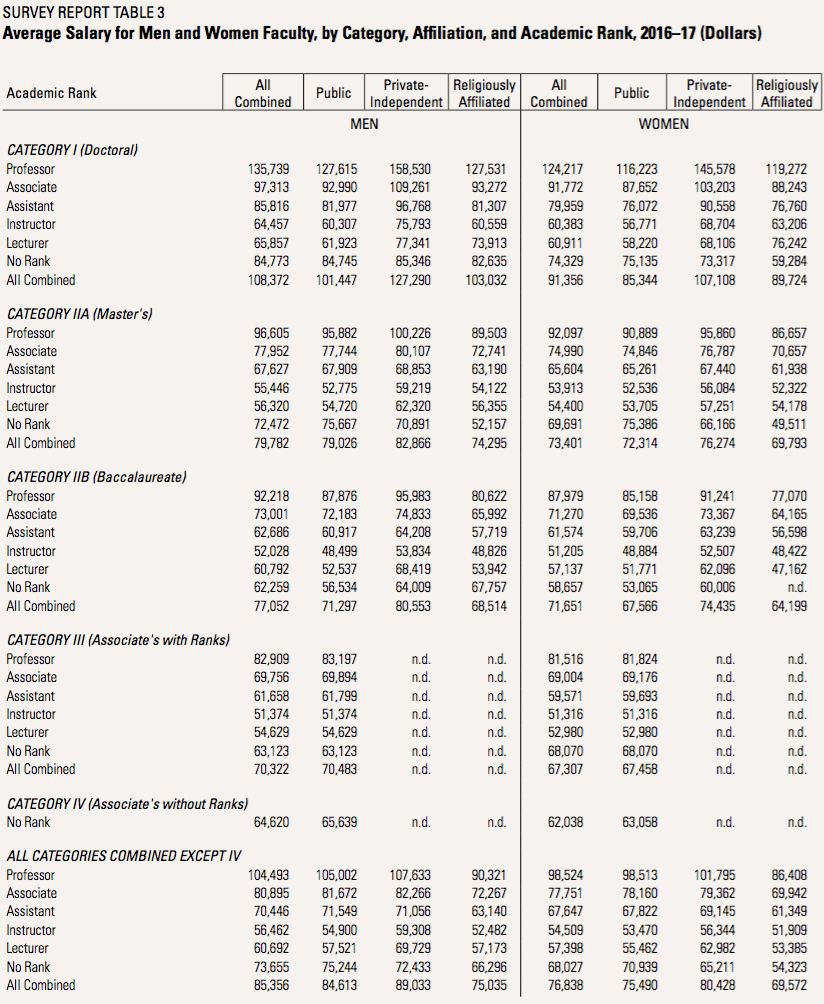
AAUP explains these gender disparities, in part, by disciplinary pay differences. “The results of several discipline-level salary surveys consistently reveal that higher-paying disciplines, such as business management, biological sciences, engineering and mathematics, tend to be disproportionately male-dominated,” the report reads, “while lower-paying disciplines such as English, sociology and women’s and gender studies have a disproportionately high number of female faculty. When male faculty members are overrepresented in higher-paying disciplines, it is not surprising to find gender disparity at the institutional level.”
Coasts vs. Midwest and South
As in past years, professors tended to make the most in New England (full-time professor average professor pay: $93,730), the Middle Atlantic ($85,593) and the West (Pacific, $92,891, and Mountain, $74,640). The lowest annual salaries were found in the Midwest ($69,547) and East South Central region ($70,057).
The report notes that while the cost of living is a major factor in faculty salaries, so, too, may be political representation and collective bargaining. “Faculty salaries, particularly at public institutions, tend to be higher where there is a strong commitment to state financing of public higher education,” AAUP says, and where faculties have unionized.
Administrators vs. Faculty Members
AAUP is a longtime critic of institutions’ budgetary priorities, and this year’s faculty compensation report is no exception. It points out that the average salary this year for college and university presidents was $334,617, a 4.3 percent jump from 2015-16, not adjusted for inflation.
“Presidents now earn nearly four times as much as full professors at private doctoral institutions and more than three and a half times as much as those at public doctoral institutions,” the report says. “Other senior administrators also earn substantially more than full professors. The average salary for chief academic officers in 2016-17 was $212,774, and the average salary for chief financial officers was $202,048.”
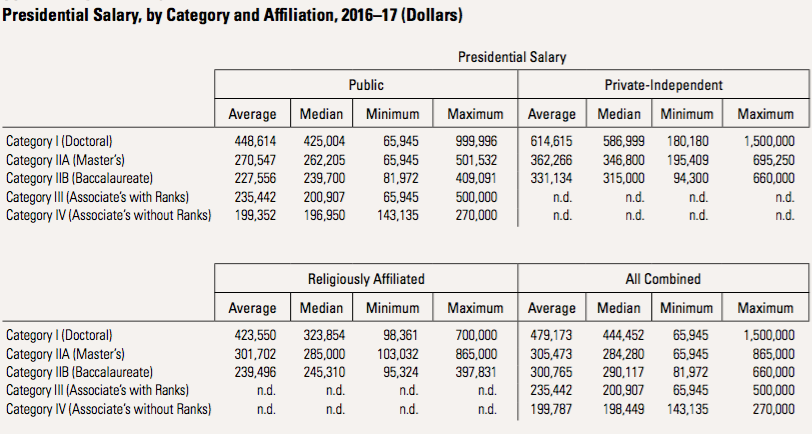
Full-time vs. Part-Time Professors
Homing in on another longtime concern -- the decline of tenure-track positions -- AAUP says that the share of adjuncts teaching across higher ed has increased 66 percent in the past four decades. Adjuncts now make up 40 percent of the academic labor force at institutions surveyed, according to federal data, “a slightly larger share than tenured and tenure-track faculty combined,” while average total pay, per institution, for these instructors is $20,508.
Pay for adjuncts teaching on a per-section basis only is $7,066 on average, per institution. AAUP warns that “caution is warranted” here, since, at “many institutions, the only readily available pieces of information about part-time faculty members teaching on a per-section basis are the total amount paid to those faculty members and the number of those faculty members being paid. … Because many faculty members teach more than one section of a course, this average is greater than the amount a part-time faculty member would be paid per section.”
Dunietz, of AAUP, emphasized that the statistic is “not meant to indicate an average pay per course,” but rather the average salaries of those part-time faculty that are paid on a per-course basis. “Some of these faculty may teach two or three courses, and the data that we have doesn’t differentiate between cost per course,” he added.
CUPA-HR's recent survey included responses on adjunct pay from a limited number of institutions. The average was about $1,000 per credit taught.
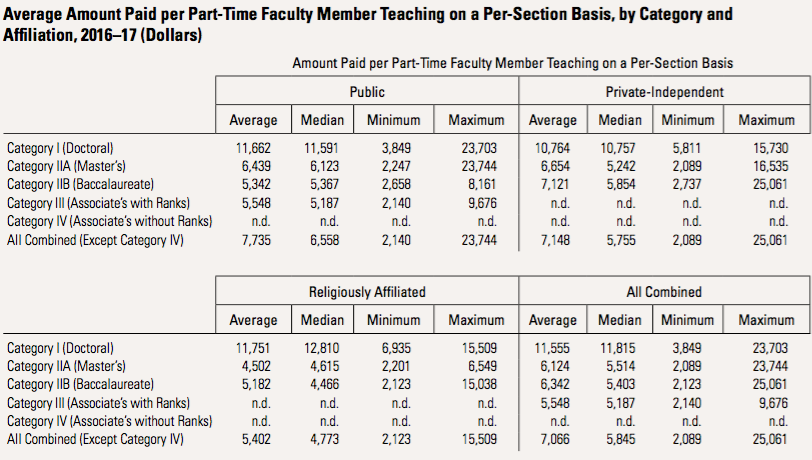
Despite this limitation, AAUP says, inclusion of part-time faculty data in the annual report marks an “important step” toward benchmarking per-section pay data. In any case, the report reads, “The average pay from a single institution for part-time faculty teaching on a per-section basis is well below the federal poverty line of $16,240 for a family of two. Even if we assume that a part-time faculty member teaches three courses at one institution and three at another, the earnings from those courses would still likely place him or her near the poverty line.” Moreover, it says, benefits are typically nil for these faculty members.
Republican vs. Democrats and State Funding
The economic picture for adjuncts and other faculty members likely won’t improve under the all-Republican federal administration, AAUP adds, and the “expansion of Republican control of state legislatures and governorships will have dramatic effects on faculty compensation for years to come. The potential full repeal of the Affordable Care Act could cause health-insurance premiums to increase and would likely place additional burdens on part-time faculty. With appropriations for higher education still lagging behind pre-recession levels, faculty should expect a prolonged period of little growth in salaries.”
Why? State appropriations for higher education remain uneven, and those in Republican-dominated states, in particular, struggle to catch up to pre-2008 levels, especially when enrollment growth is taken into account. For example, AAUP says, “total state appropriations increased nationally by just over 4 percent between 2015 and 2016,” but that growth “was overshadowed by the 16 percent decline in appropriations that occurred in years immediately following the recession, between 2009 and 2013. … Six of the 10 states with the largest increases in appropriations between 2015 and 2016 leaned toward or were controlled by Democrats. Conversely, eight of the 10 states with the lowest percentage change in state appropriations leaned toward or were controlled by Republicans.”
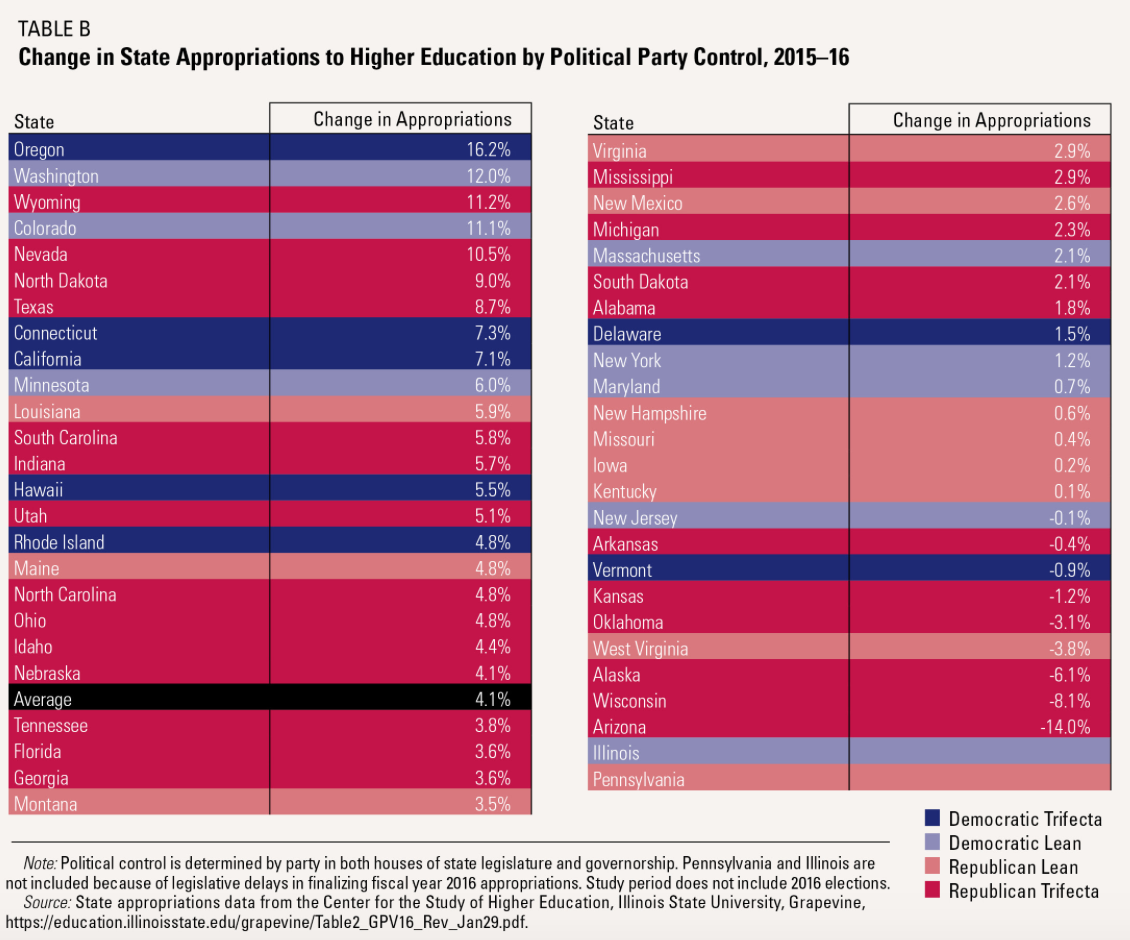
AAUP also says that decreases in state appropriations since 2008 have contributed to net tuition price increases at public institutions.
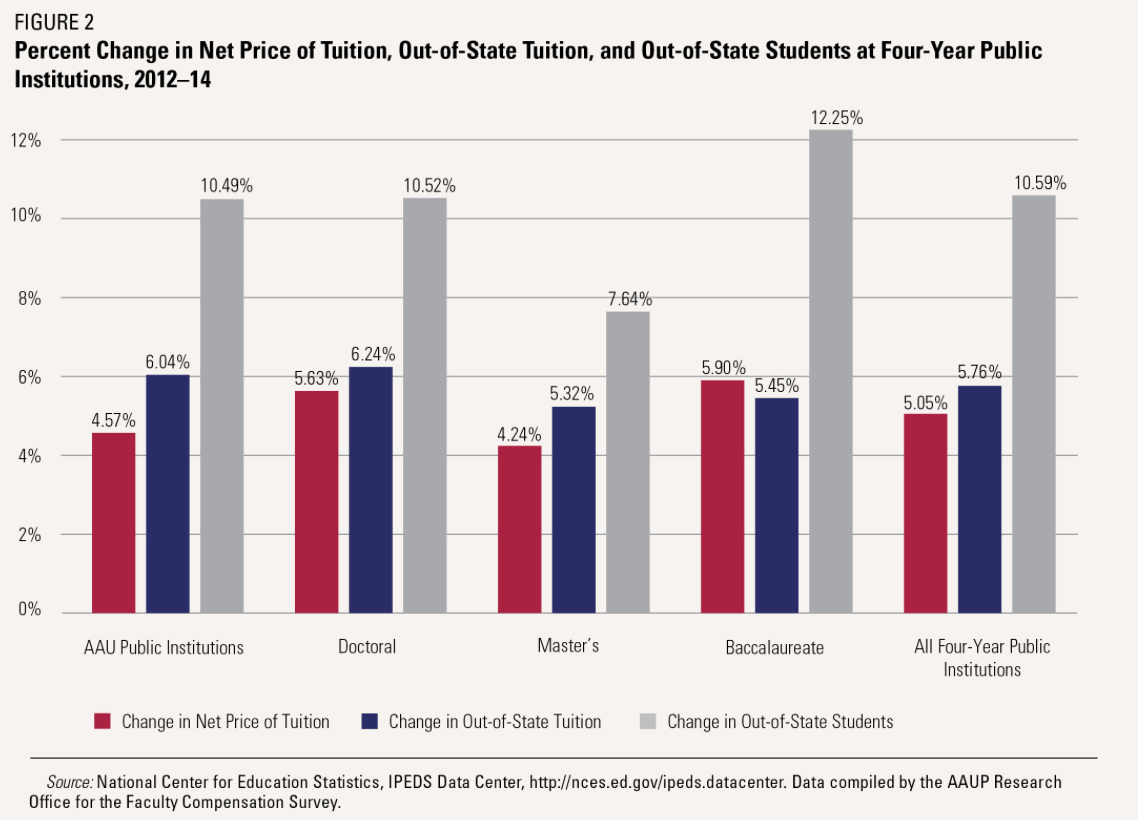
More than that, said Howard Bunsis, professor of accounting at Eastern Michigan University and a member of the AAUP Council’s executive committee, the declining public commitment to higher education is “making it harder for students and their families to afford an education. The students today have it harder than ever, and we are not doing enough to help students succeed.”
Summing up AAUP’s concerns about adjunct faculty members, Bunsis said that administrators continue to rely on them for teaching needs, evidenced by the fact that they’re now the largest component of the professoriate. Yet “these dedicated part-time faculty work for low compensation, no security and no benefits.”
Maria Maisto, president of the New Faculty Majority, a national adjunct advocacy organization, said the incomplete nature of data on adjuncts in AAUP's survey and other sources makes clear the "critical need" for mandatory, comprehensive data collection on part-time faculty compensation -- as opposed to voluntary survey responses -- "so that the public realizes the real scope of the disparity in compensation affecting the faculty doing what is arguably the most essential work in higher education."
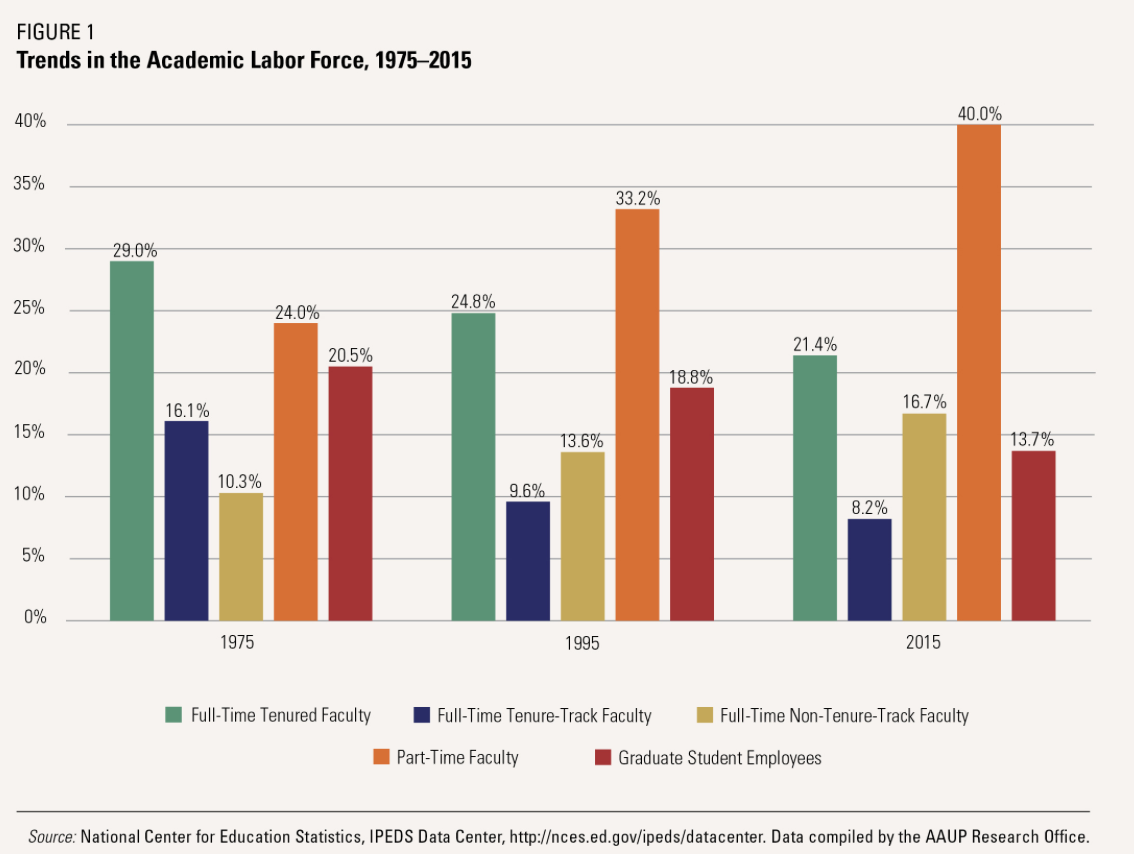
The Highly Paid vs. the Not-So-Highly Paid
Here's data on average salary and compensation (including benefits) for faculty members across disciplines across academe, by rank and institution type, followed by information about the highest-paid faculty members nationwide:
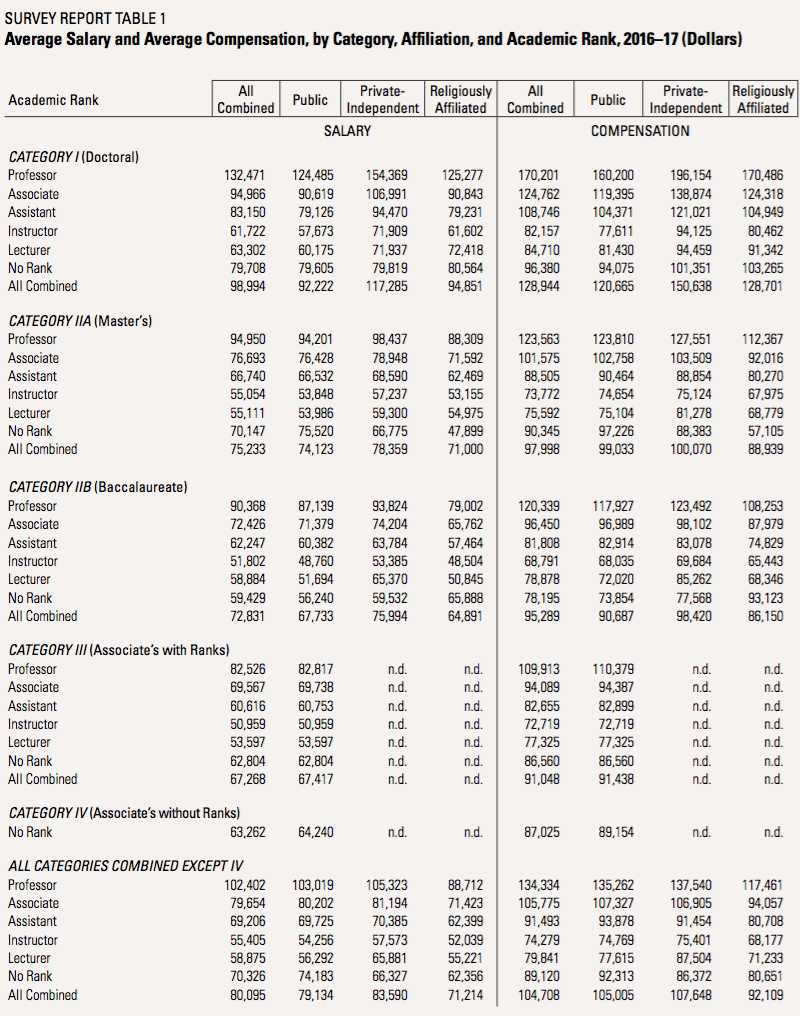
Among private institutions, Columbia University retained the same spot year over year for highest full professor pay. The University of Chicago fell two slots from last year, to No. 4, while Stanford University moved up one, to No. 2. Princeton University jumped up two spots, to No. 3. The Massachusetts Institute of Technology jumped two, to No. 6, while New York University fell three slots, to No. 9. Duke University pushed Johns Hopkins University out of the top 10 in this category.
Top Salaries for Full Professors at Private Universities, 2016-17 (Average)
| 1. | Columbia University | $244,400 |
| 2. | Stanford University | $236,600 |
| 3. | Princeton University | $229,400 |
| 4. | University of Chicago | $228,100 |
| 5. | Harvard University | $227,700 |
| 6. | Massachusetts Institute of Technology | $212,100 |
| 7. | Yale University | $209, 500 |
| 8. | University of Pennsylvania | $209,200 |
| 9. | New York University | $205,600 |
| 10. | Duke University | $204,200 |
The top 10 public institutions for full professor pay are very similar to last year's. Among other small changes, the University of Michigan at Ann Arbor fell two slots, to No. 6, while the University of Maryland at Baltimore jumped to No. 8 from No. 10.
Top Salaries for Full Professors at Public Universities, 2016-17 (Average)
| 1. | University of California, Los Angeles | $195,000 |
| 2. | University of California, Berkeley | $185,100 |
| 3. | Rutgers University, Newark | $178,800 |
| 4. | University of Virginia | $172,400 |
| 5. | University of California, Santa Barbara | $169,600 |
| 6. | University of Michigan, Ann Arbor | $168,400 |
| 7. | University of California, Irvine | $165,700 |
| 8. | University of Maryland, Baltimore | $165,500 |
| 9. | University of California, San Diego | $164,200 |
| 10. | Rutgers University, New Brunswick | $163,500 |
The top 10 liberal arts institutions for full professors in term of pays were virtually unchanged since last year, except that Barnard College and Claremont McKenna College flipped within the top two slots.
Top Salaries for Full Professors at Liberal Arts Colleges, 2016-17 (Average)
| 1. | Barnard College | $164,000 |
| 2. | Claremont McKenna College | $163,300 |
| 3. | Wellesley College | $157,500 |
| 4. | Pomona College | $154,900 |
| 5. | Amherst College | $149,900 |
| 6. | Wesleyan University | $149,400 |
| 7. | Swarthmore College | $149,300 |
| 8. | Harvey Mudd College | $148,100 |
| 9. | Williams College | $143,700 |
| 10. | Colgate University | $143,000 |
Assistant professors earned most this year at many of the same 10 institutions as last year. Harvard and Columbia switched places year over year, however, for fifth and sixth place, respectively. Bentley and Northwestern Universities also entered the top 10 in this category, as Johns Hopkins and NYU fell out.
Top 10 Colleges With Six-Figure Salaries for Assistant Professors, 2016-17 (Average)
| 1. | Babson College | $131,700 |
| 2. | Stanford University | $128,200 |
| 3. | California Institute of Technology | $127,900 |
| 4. | University of Pennsylvania | $127,500 |
| 5. | Harvard University | $123,700 |
| 6. | Columbia University | $122,800 |
| 7. | Massachusetts Institute of Technology | $120,600 |
| 8. | Bentley University | $118,600 |
| 9. | University of Chicago | $118,200 |
| 10. | Northwestern University | $117,200 |









